Athletic director Dave Heeke Varsity teams 18 | ||
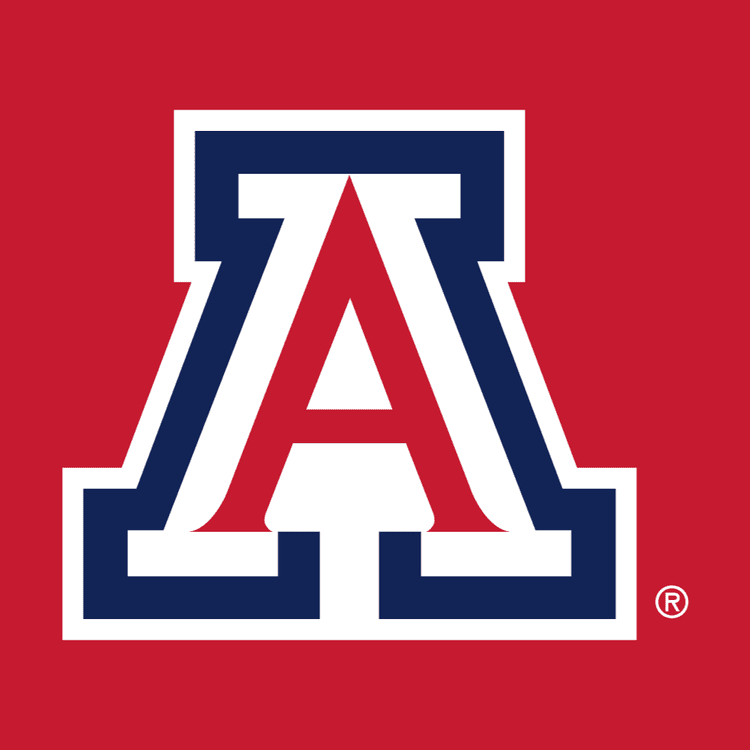 | ||
The athletic teams at the University of Arizona are known as the Arizona Wildcats.
Contents
- Athletic program
- History
- Mascot
- Rivalries
- Varsity sports
- Mens basketball
- Womens basketball
- Football
- Baseball
- Softball
- Mens and womens golf
- Swimming
- Synchronized Swimming
- Mens tennis
- Notable non varsity teams
- Mens ice hockey
- Mens lacrosse
- Rugby
- NCAA team championships
- Notable athletic venues
- Traditions
- History of Bear Down Arizona
- History behind the motto Bear Down
- Fight Wildcats Fight
- References
Athletic program
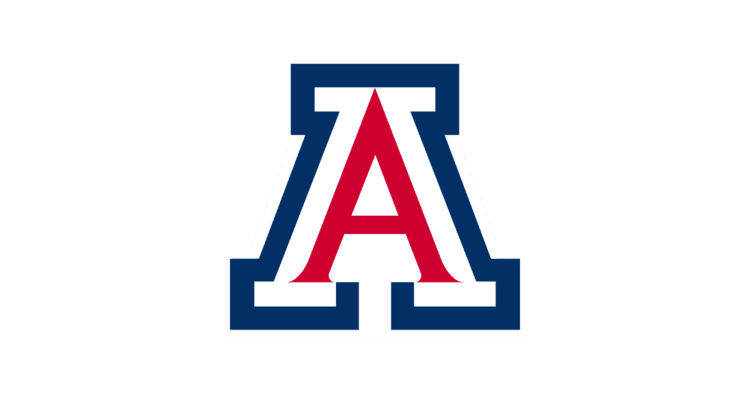
The University of Arizona participates in the NCAA's Division I-A in the Pac-12 Conference Arizona participates in the conference's South Division, along with Arizona State, Colorado, UCLA, USC, and Utah. Arizona joined the Pac-8 in 1978 along with Arizona State University, bringing the conference to 10 teams and the new name of the Pac-10 (the conference became the Pac-12 with the additions of Colorado and Utah in 2011). The school colors are cardinal red and navy blue since 1900, though originally sage green and silver. The official fight song is "Fight! Wildcats! Fight!", though "Bear Down, Arizona!" is more commonly used and "Bear Down" is the university's slogan.
History
The Wildcats name derived from a 1914 football game with then California champions Occidental College, where the L.A. Times asserted that Arizona "showed the fight of wildcats."
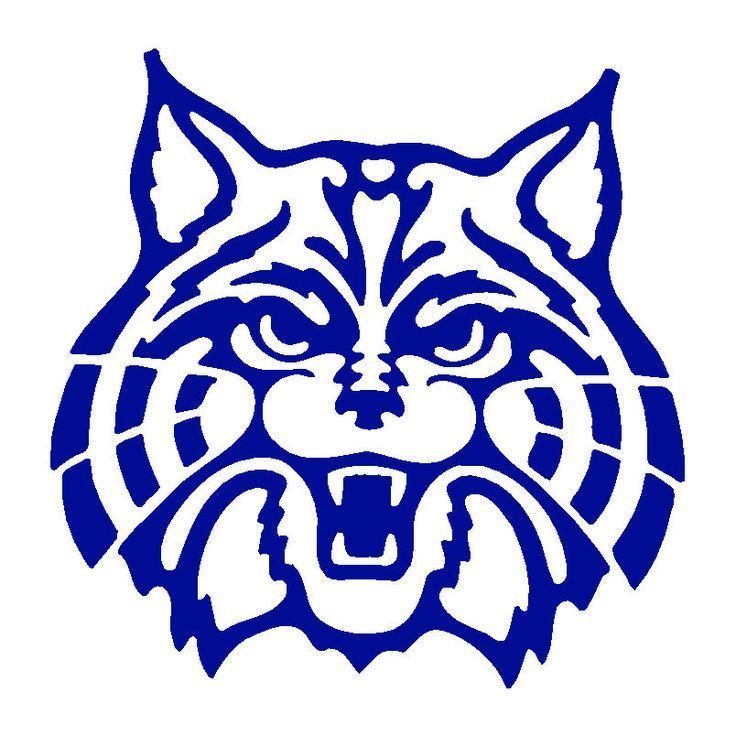
Mascot
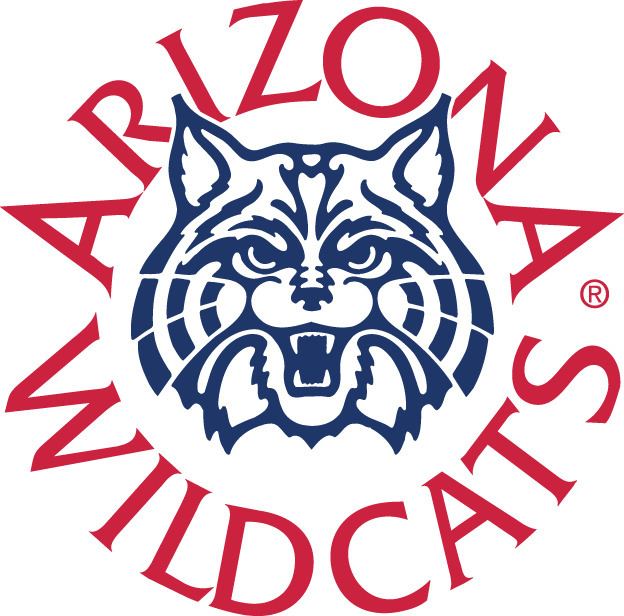
The University mascots are anthropomorphized wildcats named Wilbur and Wilma. The identities of Wilbur and Wilma are kept secret through the year as the mascots appear only in costume, except typically until the last home basketball game of the year. Then, at halftime, Wilbur and Wilma are exposed. In 1986, Wilbur and Wilma, a longtime couple, were married. Together, Wilbur and Wilma appear along with the cheerleading squad at most Wildcat sporting events.
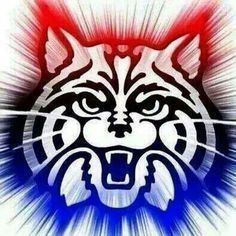
Arizona's first mascot was a real desert bobcat named "Rufus Arizona", introduced in 1915 and named after the university's president at the time, Rufus B. von KleinSmid.
Rivalries
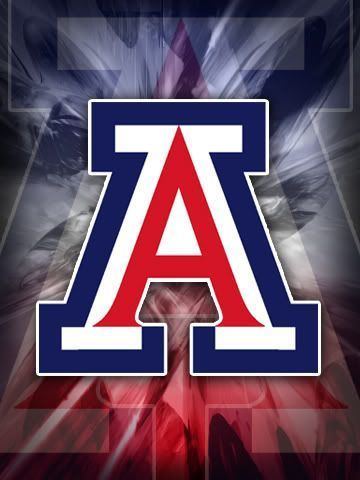
A strong athletic rivalry exists between the University of Arizona Wildcats and Arizona State University Sun Devils, the state's only two Division I-FBS teams. The rivalry has been recognized as one of the most bitter rivalries in college sports. Both schools compete in the State Farm Territorial Cup Series, a head to head competition in 18 different sports. The football rivalry, nicknamed "The Duel in the Desert," is the oldest rivalry game in college football that features a trophy. The trophy awarded after each football game is the Territorial Cup as the teams first played in 1899, while the Territory of Arizona was an organized incorporated territory of the United States.
Rivalries have also been created with other Pac-12 teams, especially University of California, Los Angeles which has been a consistent softball rival and was Arizona's main Men's basketball rival from the late 1980s to present.
Outside of the Pac-12, Arizona has two dormant rivalries with two other former Border Intercollegiate Athletic Association members, the New Mexico Lobos and Texas Tech Red Raiders. Although Arizona remained in the Border Conference until it folded in 1961, New Mexico and Texas Tech withdrew from the Border Conference in 1952 and 1956 respectively. Both football programs remained on Arizona's schedule annually until the late 1970s, even though Texas Tech was a member of the Southwest Conference and New Mexico was a member of the Skyline Eight. In 1962, Arizona and New Mexico once again became conference rivals as charter members of the Western Athletic Conference. The Kit Carson Rifle was a traveling trophy exchanged between the Wildcats and Lobos from 1938 though 1990. Prior to the 1997 Insight.com Bowl, two schools announced the Kit Carson Rifle would not be awarded to the bowl game's winner because the trophy may have been used against Native Americans.
Varsity sports
The University of Arizona sponsors teams in nine men's and twelve women's NCAA sanctioned sports:
Men's basketball
The men's basketball team has been one of the nation's most successful programs since Lute Olson was hired as head coach in 1983 and was known as a national powerhouse in Division I-A men's basketball. From 1988 to 2007, the team amassed 20 consecutive 20-win seasons. Arizona reached the NCAA Tournament in 25 consecutive years from 1985 to 2009; however, the Wildcats' 2008 appearance was later vacated by the NCAA, officially reducing the consecutive Tournament streak to 23 seasons. The Wildcats have reached the Final Four of the NCAA tournament in 1988, 1994, 1997, and 2001. In 1997, Arizona defeated the University of Kentucky, the defending national champions, to win the NCAA National Championship. Their championship team was led by future NBA players Mike Bibby and Michael Dickerson, as well as Final Four MVP Miles Simon. Bennett Davison and A. J. Bramlett rounded out the starting five. Other team members include Jason Terry, the Cats' sixth man who went on to a solid NBA career, John Ash, Eugene Edgerson, Donnell Harris, Jason Lee, Josh Pastner, Jason Stewart, Quynn Tebbs and Justin Wessel. To this date, they are the only team to defeat three number one seeds in the same tournament: Kansas (Sweet 16); North Carolina (Final 4); and Kentucky in the Championship Game. They won a thriller game in the Elite Eight in double overtime to take them to the Final Four (NCAA Men's Division I Basketball Championship).
Arizona also has a history of first round upset losses in the NCAA tournament, including being one of only seven teams in history to lose a game as a 2 seed (to Santa Clara, in 1993), one of only seventeen 3 seeds to lose a game (to East Tennessee State, in 1992), and one of twenty-five 4 seeds to lose a game (to Oklahoma, in 1999).
After 25 years of coaching Arizona, Lute Olson retired shortly before the 2008–2009 season, largely due to on-going health issues. After several years of coaching by interim head coaches, Arizona named Sean Miller, formerly the head coach of Xavier, as the next Wildcats head coach. In the NCAA Tournament, Sean Miller lead the Wildcats to 3 Elite Eight appearances (2011, 2014, 2015).
Women's basketball
The women's basketball program began in its current form in 1972. Before that, it existed as an intramural sport. The team has twice been runner-up in the Pac-10 (forerunner of the Pac-12) Conference Tournament and has made seven appearances in NCAA tournaments, and gone abroad to play in four foreign countries. The program has had eight coaches in its forty-plus years and as of the onset of the 2015-2016 season, and all-time game record of 537-642.
Football
The football team began at the University of Arizona in 1899 under the nickname "Varsity" (a name kept until the 1914 season when the team earned the name "Wildcats"). The football team was notably successful in the 1990s under head coach Dick Tomey and his "Desert Swarm" defense that was characterized by tough, hard-nosed tactics. In 1993, the team had its first 10-win season and drubbed the powerhouse Miami Hurricanes in the Fiesta Bowl by a score of 29–0. In 1998, the team posted a school-record 12–1 season and made the Holiday Bowl in which it defeated the Nebraska Cornhuskers. Arizona ended that season ranked 3rd nationally and 2nd in several publications. Despite a stellar season, Arizona's single loss to UCLA caused the team to finish second in the Pac-10. From 1999–2007 Arizona has had a mix of unsuccessful seasons without any bowl appearances. Then in 2008 Arizona returned to prominence with a successful season and a bowl win against BYU in the Las Vegas Bowl. Arizona has started to build up its old time success with a 6–2 record, and an appearance in the BCS standings ranked #18. This is the first time they have been ranked in the BCS poll since 1998. After their win against Washington State, Arizona was bowl eligible for the 3rd time in 4 years. After a win against USC, Arizona along with Nebraska was invited to the Pacific Life Holiday Bowl. It was the first time since 1998 that Arizona had played in the Holiday Bowl and the second time both schools have meet each other at the bowl game. From November 2003 until October 2011, the program was led by Mike Stoops, brother of Bob Stoops, the head football coach at the University of Oklahoma (the 2000 BCS national champions); Stoops was fired on October 10, 2011.
Former Michigan and West Virginia head coach Rich Rodriguez was hired on November 21, 2011 to lead the Wildcats. The announcement was made by UA athletic director Greg Byrne via Twitter. In his first season, Rodriguez took the Wildcats to the 2012 New Mexico Bowl, where they defeated the University of Nevada Wolfpack. The Wildcats finished the 2012 campaign with a (8–5, 4–5 Pac-12) record. In his second season, Rodriguez took the Wildcats to the 2013 AdvoCare V100 Bowl, where they defeated Boston College. The Wildcats finished the 2013 campaign with a (8–5, 4–5 Pac-12) record. In 2014, Rich Rodriguez led the Wildcats to a 10-3 regular season, behind generally solid team performance, including efforts from freshman QB Anu Solomon, sophomore LB Scooby Wright (who earned Pac-12 Defensive Player of the Year among other honors), senior RB Terris Jones-Grigsby and freshman RB Nick Wilson. The Wildcats won the Pac-12 South Division, the first divisional championship in program history, advancing to the Pac-12 Football Championship Game at Levi's Stadium in Santa Clara, California, where they were defeated by the Oregon Ducks, 51-13. The Wildcats then played in the first College Football Playoff appearance, netting a berth in the 2014 Fiesta Bowl, the school's third major-bowl appearance, where they faced the Boise State Broncos. Arizona lost the game to Boise State, 38–30. The Wildcats finished the 2014 season with a record of 10–4 (7–2 Pac-12), achieving only the second 10-win regular season in program history; the Wildcats also finished the season ranked #17 in the USA Today Coaches Poll and #19 in the AP Poll.
Baseball
The baseball team is consistently one of the top teams in the country and has captured four national championship titles in 1976, 1980, 1986, and 2012. Arizona baseball teams have appeared in the NCAA College World Series a total of 17 times, including 1954, 1955, 1956, 1958, 1959, 1960, 1963, 1966, 1970, 1976, 1979, 1980, 1985, 1986, 2004, 2012, 2016 (College World Series). The team is currently coached by Head coach Jay Johnson. Johnson was hired by Athletic Director Greg Byrne in 2015 after Andy Lopez' retirement.
Softball
The Arizona softball program has arguably been the best college softball program over the last 20 years. The softball team has won eight NCAA Women's College World Series titles, in 1991, 1993, 1994, 1996, 1997, 2001, 2006 and 2007 under head coach Mike Candrea (NCAA Softball Championship). The team has appeared in the NCAA National Championship in 1991, 1992, 1993, 1994, 1995, 1996, 1997, 1998, 2001, 2002, 2006, 2007 and 2010, a feat second only to UCLA. Mike Candrea also led the 2004 U.S. Olympic softball team to a gold medal in Athens, Greece.
Men's and women's golf
The university's golf teams have also been notably successful. The men's team won a national championship in 1992, while the women's team won national championships in 1996 and 2000. Annika Sörenstam won an individual national title in 1991, and Lorena Ochoa was NCAA Women's Player of the Year in 2001 and 2002 before leaving UA early to turn pro. Jim Furyk, the 2003 U.S. Open champion attended the University of Arizona prior to turning professional in 1992. The men's team has won three Pac-12 Conference championships (1987, 1991, 2004).
Swimming
The women's and men's swimming & diving team won their first national championships in 2008.
In 2014-2015, women's team member Margo Geer was named the Pac-12 Conference Woman of the Year for the 2014-15 academic year.
Synchronized Swimming
Three championships for synchronized swimming were won in 1980, 1981, and 1984, though these championships were in the Association of Intercollegiate Athletics for Women, and not the NCAA.
Men's tennis
Arizona is home to one of the most prominent men's tennis programs in the entire nation. With Arizona State's program having been cut after the 2008 season, Arizona is the premier men's tennis program in the state. With matches being held at the Lanelle Robson Tennis Center, matches generally draw hundreds to thousands of spectators. The program is currently led by head coach Tad Berkowitz and assistant coach Tom Lloyd. Lloyd is a former member of the team.
Notable non varsity teams
Arizona has three sports in its "Cactus Tier", an elevated level of intercollegiate club competition: ice hockey, lacrosse, and rugby.
Men's ice hockey
The men's ice hockey team was established in 1979 by Head Coach and General Manager Leo Golembiewski as a Division-1 non-varsity hockey team, the team was originally known as the Arizona IceCats. The team was one of the founding programs of the American Collegiate Hockey Association (ACHA) in 1991; and competes as an independent program at the ACHA Division I level.
The team has played at the 7,000-seat Tucson Convention Center, affectionately known as "The Madhouse on Main Street," since the 1980-81 season and are consistently one of the University's top draws with an average attendance of 3,000 fans per game.
Coach Golembiewski retired after 32 seasons as coach and general manager of the team at the conclusion of the 2010-2011 season. Golembiewski compiled a record of 634-217-23, in addition the IceCats won a National Tournament in 1985 and appeared in the National Tournament twenty-one straight seasons prior to 2004, including in eight Final Fours (’84, ’86, ’87, ’88, ’91, ’93, ’94, ’97).
The program was reorganized in 2011 under new head coach Sean Hogan. The team changed its name to the university's official 'Wildcats' name and changed the managerial structure in the whole organization. The new Wildcat hockey team is organized under the auspices of the Campus Recreation Department and began receiving increased financial backing from the university, which they have never had in their history under former Head Coach and General Manager Leo Golembiewski.
For the majority of the program's existence, the ice hockey team has competed independent of a conference. The IceCats were originally part of the Intercollegiate Pacific Conference, and later Pacific Hockey Conference, from 1980 until the formation of the ACHA in 1991. Beginning in the 2013-14 season, the team will join the newly formed Western Collegiate Hockey League (WCHL). The new conference will be made of six member teams, including rival Arizona State.
Men's lacrosse
The lacrosse team is affectionately known as the "Laxcats" currently competes in the Men's Collegiate Lacrosse Association (MCLA) at the MCLA Division I level in the Southwestern Lacrosse Conference. Lacrosse at U of A has existed since the mid-sixties, and is saturated with a rich tradition of success. In the 1960s, Arizona was a Division I Varsity program, coached by the legendary Carl Runk, an Arizona graduate and football player. In 1998 Carl retired after twenty-eight years at Towson University in Maryland. The most well known player to graduate from that era was Geraldo Rivera, who played goalie. During that Varsity era, the team rose as high as number 3 in the Nation.
In the early 70’s Craig Hassell, a transplanted Long Island lacrosse fanatic, stepped up and kept the tradition alive. The 70’s rosters were packed with the types of free spirited players that typified the era. Predominately from Long Island and Maryland, these free spirits had little cares other than their dedication to the game. In 1976, the timing was right for yet another transplanted Long Islander to assume the responsibility for the stability of the University of Arizona Program. Mickey-Miles Felton, at the age of 30, had begun his Arizona career as a defenseman, was named the head coach.
The Laxcats have claimed only one Conference Title, occurring in 1990. In 1997, the Laxcats were ranked Number 1 heading into the National Tournament but were upset early by Brigham Young University in the second round of the Tournament. Following the 2001 season Mickey-Miles Felton stepped down with 278 career wins to assume the role of General Manager. Assistant Coach Adam Hopkins, of New York Institute of Technology, was elevated to the top spot and the Tradition continued. Following the 2003 season, Hopkins left and his assistant Ken Broschart was moved into the Head Coaching position. Broschart brought in Matt Hunter, and the following year Tim Spruyt as the NYIT pipeline continued. Hopkins, Broschart, and Hunter were all All Americans while at NYIT. In 2013, Derek Pedrick was named the U of A head coach. Pedrick was previously the head coach at NCAA Division II Notre Dame de Namur University, and held assistant gigs at Siena College in upstate New York and the College of Wooster in Ohio.
Rugby
Founded in 1969, the University of Arizona rugby program plays in the PAC Rugby Conference against its conference rivals such as Arizona State and Utah. The Wildcats were led by head coach Dave Sitton from 1979 to 2013, who served as a board member of USA Rugby, and also worked as a rugby broadcaster for ESPN and Fox.
The Wildcats have become one of the most successful college rugby programs in the country. The Wildcats reached the quarterfinals of the 2010 national collegiate rugby championships. The Wildcats reached the playoffs in 2013, but lost in an upset to Long Beach. The Wildcats reached the D1-AA national playoffs in 2014, where they defeated Long Beach State, Stanford, and Bowling Green, but ultimately lost to Central Florida in the final.
The Wildcats have a successful rugby sevens program. Arizona has regularly reached the quarterfinals of the Collegiate Rugby Championship (CRC), the highest profile college rugby competition in the U.S., and the Wildcats finished second at the 2012 CRC. The CRC is played every June in Philadelphia and is broadcast live on NBC. Arizona's best known rugby players include Peter Tiberio and Brett Thompson, who play for the U.S. national rugby team.
NCAA team championships
Arizona has won 18 NCAA team national championships.
Notable athletic venues
Traditions
History of Bear Down, Arizona!
In 1952 Jack K. Lee, an applicant for the UA's band directorship, departed Tucson by air following an interview with UA administration. From his airplane window, Lee observed the huge letters on the roof of the UA gymnasium reading "BEAR DOWN". Inspired, Lee scribbled down what was at first a poem, but later turned into a song. By the time his plane landed, he had virtually finished it. A few weeks later Lee was named the UA band director, and in September 1952, the UA band performed "Bear Down, Arizona!" in public for the first time. Soon thereafter, "Bear Down, Arizona!" became accepted as UA's fight song despite the fact that the Chicago Bears fight song, "Bear Down, Chicago Bears", was introduced in 1941.
History behind the motto Bear Down
The battle cry was created by a popular student athlete, John "Button" Salmon, who was the student body president, as well as the starting quarterback for the Wildcat football team and the catcher for the Wildcat baseball team.
The day before the first game of the 1926 football season, Salmon and three friends were involved in an automobile accident and their vehicle flipped over a ravine. Although Salmon's friends were not injured, Salmon suffered a severe spinal cord injury.
In the aftermath of the accident, football coach Pop McKale visited him in the hospital every day. During McKale's last visit, Salmon's last message to his teammates was, "Tell them...tell the team to bear down." John Salmon died on October 18, 1926.
The following year, the University of Arizona student body approved that "Bear Down" would be the new slogan for all Wildcat athletic teams. In 1939, the Arizona state legislature issued a decree that "Bear Down" would be the exclusive property of the University of Arizona.
Fight! Wildcats! Fight!
Hail Arizona Wildcats
Fighting for old UA
A raging team of Wildcats
Growling for the fray
There's not a team that can stop them
When the ball goes into play
So Fight! Team!
Fight with all your might
And win today!
Fight, Wildcats, Fight for Arizona
We're with you ever staunch and true
This day we hail you and we cheer you
They can't defeat the Red and Blue
Circle the ends and crash through the center
Hit hard and gain on ev'ry play
Fight Wildcats
Fight! Fight! Fight!
We'll win today!
